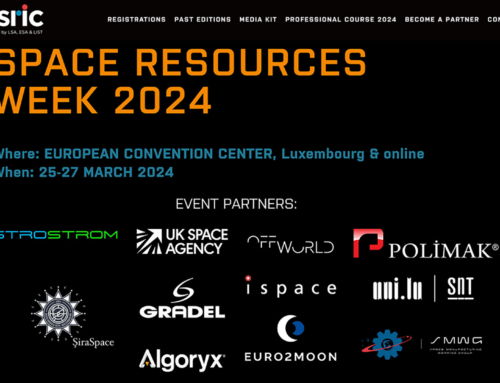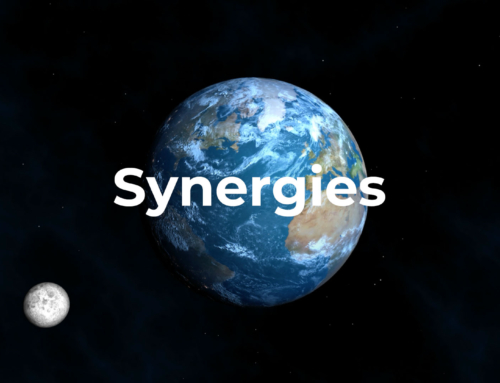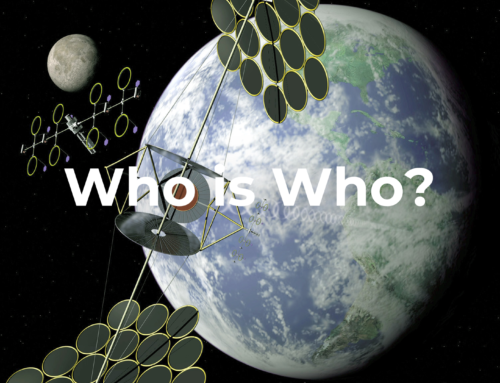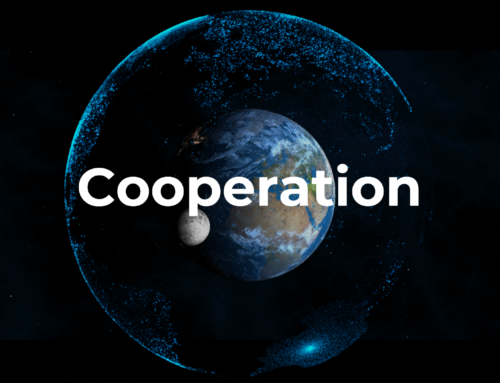In this discussion at the Dubai Futures Forum that took place during COP 28 in 2023, the space experts allude to the eventual use of lunar resources for the manufacture of Space Solar Power components to supply Earth with sustainable clean energy.
Astrostrom GmbH has been investigating the feasibility of a “Greater Earth Lunar Power Station” (GE⊕-LPS) manufactured on the Moon and assembled at the Earth-Moon Lagrange Point 1 to provide power from lunar orbit to operations on the surface of the Moon. If shown to be both feasible and scalable, manufacturing future SPS components from lunar materials and transporting these to geostationary orbit (GEO), would be a means to avoid the need to launch hundreds or thousands of massive SPSs from the surface of the Earth in order to supply environmentally benign, baseload electricity to Earth. Astrostrom has also analysed the GE⊕-LPS concept in its macro-economic context that considers competing approaches to terrestrial and space-based solar power producing systems. Links to the ESA funded study are listed below.
Prof. Naoki Shinohara from Kyoto University, Dr. John Mankins from Artemis Innovation Management Solutions, Dr. Sanjay Vijendran from the European Space Agency, and moderated by Sahba El-Shawa from the Jordan Space Research Initiative discussing energy from space at the Dubai Future Forum 2023.
Video (10 min)
The full 51 min video can be viewed on YouTube:
Out of this World: Why Does Space Hold So Much Potential for Energy?
Dubai Future Foundation
https://www.youtube.com/watch?v=AMWf37kmJ3M&t=1718s
Transcript:
Video Introduction
This discussion about Space-Based Solar Power took place at the Dubai Future Forum in the context of the 28th United Nations Climate Change conference (COP28) on December 6th 2023.
Moderator: Sahba El-Shawa, Jordan
Hello everyone, welcome to this really exciting panel and I am very happy to be moderating today my name is Sahba El-Shawa. I am the founder of the Jordan Space Research Initiative we work on bridging space with sustainable development which is also what I’m researching in my PhD on space and sustainability, so I’m very happy to be talking to these experts today about Space-Based Solar Power (SBSP), which if you don’t know, is a really fascinating field and has a lot to do with sustainability. So, I will let each of our experts introduce themselves and then we’ll dive into the discussion. We will have a bit of time at the end for Q&A, so if you have any burning questions, hold on to them and we’ll get to that in the last 10 minutes so.
Now I think especially with lunar exploration we are seeing now a lot more countries are getting involved in this direction and you know historically, space has been more or less dominated by a handful of very strong players in that field, but now you can see even, you know with the UAE or Saudi Arabia, or even countries like Jordan that doesn’t have a space program. are all contributing in different ways.
Professor Naoki Shinohara, Japan
My major research topics are wireless power transfer and SSP (Space Solar Power) from my student time so now about over 30 years, I spent all my research life for SBSP and wireless so thank you so much.
Of course, now it is a Japanese case, as you know the Japanese economy is now is very weak and we don’t have enough budget. So, to impose meaning we act to appraise SSP technology and mainly wireless technology to the lunar Moon base and from the gateway orbit onto the Moon. Now we have some feasibility studies to appraise the wireless power from the gateway to the Moon. We maybe we can apply this as a spot transfer to drive the Moon robots. Which I think is superior technology with the SBSP which can be appraised to excite or encourage Moon technology or the Moon research. This is a Japanese trial.
Dr. John Mankins, USA
Good afternoon my name is John Mankins. I’ve also been working in the field of Space Solar Power like Shinohara Sensei for just about 30 years. I was for a number of years the lead at NASA for their studies on Space Solar Power from the mid 90’s to the early 2000’s. I’ve been involved in various international activities to advance the goal of Space Solar Power including the International Academy of Astronautics and the International Astronautical Federation space power committee. I have been supporting a wide variety of global activities over the last 10-15 years and I am looking forward to discussing these with you today.
It is not so much that a Solar Power Satellite is a new kind of solar power plant and that after 15 or 20 or years you’re going to decommission it. As Sanjay mentioned, these are going to be enormous systems. They are going to be almost like new moons in Earth orbit. And with a circular economy, or with the recycling of the piece parts, these platforms will essentially provide energy to markets on Earth forever. So, they do not have a finite life that when you launch 1,000 tons of aluminium, you don’t lose it because it gets damaged. Or it can be repaired, it can be recycled, reforged to make a new structure to put it back into the system. Now by developing Space Solar Power systems in this way with an eye towards recycling and refurbishment you introduce the opportunity for the piece parts of Space Solar Power systems – Solar Power Satellites – to be gleaned from, for example the Moon. The Moon is almost entirely made-up of the molecular piece parts: the aluminium, the silicon and iron that you need to make a Solar Power Satellite.
So if you establish a an economy in space that is a circular one, where you can basically remake these materials as they fail, and refurbish and repair them, you can also expand and extend the energy that you harvest in space for Earth using extraterrestrial materials. Now this doesn’t happen in the near term. This isn’t going to happen in the next 5 or 10 or 15 years. But nevertheless, by looking at the future with a long view you can develop Solar Power Satellite systems that lend themselves to then getting a larger and larger share of their mass, until the point by later in this century where literally thousands or at least hundreds of gigawatts of completely carbon neutral energy, can be delivered to Earth from platforms that were made with materials from off-the-Earth. And this is sort of the ultimate in balancing the competing interests of a sustainable future for the world and an equitable and prosperous and high quality of life as a future for humanity. And this is one of the visions that stimulates those of us who are in the field of Space Solar Power and have been for many years.
Dr. Sanjay Vijendran, ESA
Good afternoon, everyone. My name is Sanjay Vijendran, and I am from the European Space Agency. I lead the SOLARIS research and development program for Space-Based Solar Power which is a new R&D program at the space agency to try to mature the feasibility of Space-Based Solar Power as a concept, and as a technology that we can use, hopefully to help mitigate the climate crisis. So, I have been working originally in Mars exploration which has been my background for almost 20 years, but in the last couple of years I have turned to Space-Based Solar Power because I see this technology is really promising for helping use space to mitigate the climate crisis in the short term better than we are already doing now.
Question from the audience, Fiona Bannister
I’m going to combine my question with George as well. It’s Fiona Bannister, I’ve been a small investor in ARC nuclear and small SME nuclear. And so this has a place and a role as we go further into space and also I stopped investing into solar and the like 2012. But the core that came out in deep decarbonization is how do we bring the minerals from the Moon to actually mitigate and provide, as you said, the solar that we need for our energy resources. I am going to pass this on forwards to George for a minute.
George Weinmann, Blue Origin
Well, I will let you answer her question, but I just wanted to say that Blue Origin in the room. So, I am from Blue Origin, and we are very excited about the many possibilities that could be developed in Low Earth Orbit or higher Earth orbits. As for lunar resources, we do think these will play a big role in lowering that cost so that you don’t have to bring all the resources from Earth, you can bring them from a much lower gravity well or easier gravity well which is the Moon. So, I will say that, just kind of a simple statement, there is a lot of things going on with our architecture to make lunar resources easier to use and I hope that will factor into your calculations, and we look forward to bringing the launch case cost down for you as soon as possible.
Dr. Sanjay Vijendran, ESA
Thank you for your comments that make a point about minerals. I am glad you brought up that about mineral usage because that is one of the concerns with the energy transition and, when you think about it, with ground solar there is a vast amount of minerals that are used, but then not used most of the time because of weather and the light cycle and things like that. So, this is where Space-Based Solar Power has a has a huge advantage in the sense of using the mineral resources, the precious ones we have mined out of the Earth far more efficiently, because one thing that has been mentioned here is that we are talking about power plants which with very high-capacity factors meaning that they operate most of the time. More than 90% of the time you can have power being produced by this solar power plant and so therefore it is a very efficient use of the minerals. But nonetheless, it is still going to require if you scale up Space-Based Solar Power to large numbers of satellites, and large amounts of minerals, and this is where again to John’s point about the use of lunar resources. To get those minerals from the Moon rather than from the Earth both reduces the cost and the environmental impact on the Earth itself by doing it that way. So that is a key consideration.

ESA Solaris Website: https://www.esa.int/ESA_Multimedia/Images/2023/07/Lunar_solar_power_satellite
As part of ESA’s Open Space Innovation Platform Campaign on ‘Clean Energy – New Ideas for Solar Power from Space’, a study undertaken by Astrostrom GmbH in Switzerland designed a Greater Earth Lunar Power Station, or GE⊕-LPS for short. The study envisages a solar power satellite constructed mainly from lunar resources (including Moon-manufactured solar cells) that could deliver megawatts of microwave power down to receivers on the lunar surface, serving the needs of surface activities, including future crewed bases.

ESA Nebula Archive: https://nebula.esa.int/content/ge%E2%8A%95-lunar-power-station
The Greater Earth Lunar Power Station (GE⊕-LPS) is a multipurpose concept that addresses several critical issues related to lunar development and terrestrial energy production.






